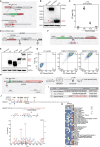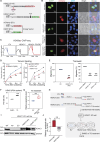Ribosomal frameshifting at normal codon repeats recodes functional chimeric proteins in human
- PMID: 38281188
- PMCID: PMC10954444
- DOI: 10.1093/nar/gkae035
Ribosomal frameshifting at normal codon repeats recodes functional chimeric proteins in human
Abstract
Ribosomal frameshifting refers to the process that ribosomes slip into +1 or -1 reading frame, thus produce chimeric trans-frame proteins. In viruses and bacteria, programmed ribosomal frameshifting can produce essential trans-frame proteins for viral replication or regulation of other biological processes. In humans, however, functional trans-frame protein derived from ribosomal frameshifting is scarcely documented. Combining multiple assays, we show that short codon repeats could act as cis-acting elements that stimulate ribosomal frameshifting in humans, abbreviated as CRFS hereafter. Using proteomic analyses, we identified many putative CRFS events from 32 normal human tissues supported by trans-frame peptides positioned at codon repeats. Finally, we show a CRFS-derived trans-frame protein (HDAC1-FS) functions by antagonizing the activities of HDAC1, thus affecting cell migration and apoptosis. These data suggest a novel type of translational recoding associated with codon repeats, which may expand the coding capacity of mRNA and diversify the regulation in human.
© The Author(s) 2024. Published by Oxford University Press on behalf of Nucleic Acids Research.
Figures





Similar articles
-
Asc1, homolog of human RACK1, prevents frameshifting in yeast by ribosomes stalled at CGA codon repeats.RNA. 2015 May;21(5):935-45. doi: 10.1261/rna.049080.114. Epub 2015 Mar 19. RNA. 2015. PMID: 25792604 Free PMC article.
-
Changed in translation: mRNA recoding by -1 programmed ribosomal frameshifting.Trends Biochem Sci. 2015 May;40(5):265-74. doi: 10.1016/j.tibs.2015.03.006. Epub 2015 Apr 4. Trends Biochem Sci. 2015. PMID: 25850333 Free PMC article. Review.
-
Slippy-Sloppy translation: a tale of programmed and induced-ribosomal frameshifting.Trends Genet. 2022 Nov;38(11):1123-1133. doi: 10.1016/j.tig.2022.05.009. Epub 2022 May 28. Trends Genet. 2022. PMID: 35641342 Review.
-
Novel application of sRNA: stimulation of ribosomal frameshifting.RNA. 2004 Nov;10(11):1702-3. doi: 10.1261/rna.7139704. RNA. 2004. PMID: 15496520 Free PMC article.
-
mRNA-Mediated Duplexes Play Dual Roles in the Regulation of Bidirectional Ribosomal Frameshifting.Int J Mol Sci. 2018 Dec 4;19(12):3867. doi: 10.3390/ijms19123867. Int J Mol Sci. 2018. PMID: 30518074 Free PMC article.
Cited by
-
Biological Significance and Therapeutic Promise of Programmed Ribosomal Frameshifting.Int J Mol Sci. 2025 Feb 3;26(3):1294. doi: 10.3390/ijms26031294. Int J Mol Sci. 2025. PMID: 39941062 Free PMC article. Review.
-
Nested small open reading frames are translated from alternative transcripts.bioRxiv [Preprint]. 2025 May 8:2024.10.22.619581. doi: 10.1101/2024.10.22.619581. bioRxiv. 2025. PMID: 39484585 Free PMC article. Preprint.
-
Interpreting ribosome dynamics during mRNA translation.J Biol Chem. 2025 Aug;301(8):110469. doi: 10.1016/j.jbc.2025.110469. Epub 2025 Jul 10. J Biol Chem. 2025. PMID: 40651611 Free PMC article. Review.
References
-
- Gesteland R.F., Atkins J.F. Recoding: dynamic reprogramming of translation. Annu. Rev. Biochem. 1996; 65:741–768. - PubMed
MeSH terms
Substances
Grants and funding
LinkOut - more resources
Full Text Sources
Molecular Biology Databases
Miscellaneous

